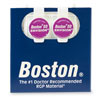LensShopper - Contact lens price comparison
Gas permeable contacts

The first gas permeable or breathable lenses were introduced to the contact lens market in 1971 by Bausch & Lomb after approval by the American Federal Drug Administration.
Gas permeable contact lenses are durable lenses with a long life expectancy and relatively high comfort level. They are designed to be replaced every 3 or 6 months, and in some cases annually. As their name suggests, they easily allow oxygen to be transmitted and thus reach the surface of the cornea. GP lenses are made from two basic types of material, one that is semi-rigid (RGP) and another that is soft. The RGP lenses have very little in common with the early hard lenses made of PMMA. Most soft breathable lenses are made of some type of hydrogel and are considerably more flexible than RGP lenses.
Most CL customers with astigmatism can be fitted with GP lenses, as they are available in cylinder powers up to about 2.50D in regular spherical lenses. For higher levels of astigmatism, soft lenses or laser surgery tend to produce clearer vision.
The rigid material of gas permeable contacts produces better visual acuity for several reasons: the lens doesn't deform when you blink, it tends to remain centered better than other lenses and the lens offers better resistance against protein and mineral deposit build-up. Another advantage of rigid lenses is that they tend to have a longer life span. They are easy to clean, and when well taken care of, can last for years. This usually makes them less expensive in the long run.
Best prices - Biofinity
- 1.
- $48.9848.98
- Discount Conta..
- 2.
- $59.1459.14
- Fresh Lens
- 3.
- $59.9959.99
- 1-800 Contacts
Search for more Biofinity contacts here!









